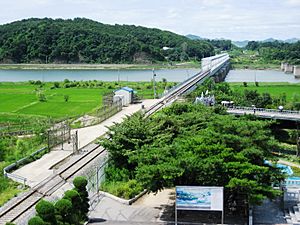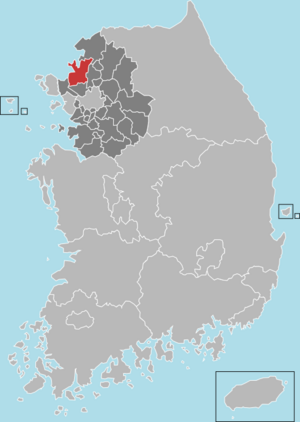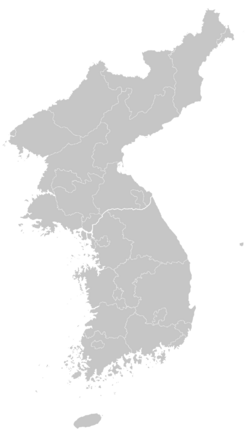Paju facts for kids
Quick facts for kids
Paju
파주시
|
||
|---|---|---|
| Korean transcription(s) | ||
| • Hangul | 파주시 | |
| • Hanja | 坡州市 | |
| • Revised Romanization | Paju-si | |
| • McCune-Reischauer | P'aju-si | |

Rail line crossing the Imjin River
|
||
|
||

Location in South Korea
|
||
| Country | ||
| Region | Gyeonggi Province (Sudogwon) | |
| Administrative divisions | 4 eup, 9 myeon, 10 dong | |
| Area | ||
| • Total | 672.78 km2 (259.76 sq mi) | |
| Population
(March 2024)
|
||
| • Total | 520,803 | |
| • Density | 774.106/km2 (2,004.925/sq mi) | |
| • Dialect | Seoul | |
Paju is a city in Gyeonggi Province, South Korea. It became a city in 1997, but before that, it was a smaller area called a county.
Paju covers about 672.78 square kilometers. It is located just south of Panmunjeom, near the 38th parallel. In 2024, more than 501,000 people lived in Paju. Many South Korean and U.S. Army bases are in the area. They help protect Seoul, the capital of South Korea.
In 2002, the Dorasan train station opened. It is the northernmost train station in South Korea. From Mount Dora in Paju, you can see North Korea and the city of Kaesong.
Contents
City Symbols: What Represents Paju?
The Cosmos Flower
The cosmos flower is a wild flower that grows in Paju during spring. It is a very strong flower and comes in colors like pale pink and red. The cosmos flower stands for unity and a peaceful life for the people of Paju.
The Ginkgo Tree
Ginkgo trees are often planted along streets. They provide high-quality wood. Their leaves and fruits are also used in traditional medicine.
The Pigeon
Pigeons are gentle birds with soft feathers. They are known to be friendly with humans. Pigeons symbolize peace and safety for everyone. In Paju, they also represent the hope for the Korean Peninsula to become one country again.
Paju City Badge
The badge of Paju City shows what the city is known for. It includes symbols for high-tech industries like semiconductors. It also shows high-quality culture, books, and the importance of rice farming. These symbols come together to form the Paju logo.
Geography: The Land of Paju
Paju has a unique landscape with lower areas in the east and west. Many mountains are found in eastern Paju, forming a border with Yangzhou. In northern Paju, mountains create the border with Goyang. Some smaller mountains also spread south through central Paju.
The two main rivers in Paju are the Imjin River and the Han River. The Imjin River flows through the northern and western parts of the city. The Han River flows through the southwestern part of Paju.
Climate: Weather in Paju
Paju has a climate with cold, dry winters and hot, rainy summers. This is called a monsoon-influenced humid continental climate. The average temperature in Paju is about 11 degrees Celsius (52 degrees Fahrenheit) each year. In January, the average temperature is around -4.6 degrees Celsius (24 degrees Fahrenheit). In August, it is about 25 degrees Celsius (77 degrees Fahrenheit). Paju gets about 1,300 millimeters (51 inches) of rain each year.
| Climate data for Paju (2002–2020 normals, extremes 2002–present) | |||||||||||||
|---|---|---|---|---|---|---|---|---|---|---|---|---|---|
| Month | Jan | Feb | Mar | Apr | May | Jun | Jul | Aug | Sep | Oct | Nov | Dec | Year |
| Record high °C (°F) | 13.4 (56.1) |
17.4 (63.3) |
23.1 (73.6) |
32.0 (89.6) |
32.0 (89.6) |
35.3 (95.5) |
36.7 (98.1) |
37.6 (99.7) |
34.5 (94.1) |
29.0 (84.2) |
26.1 (79.0) |
16.2 (61.2) |
37.6 (99.7) |
| Mean daily maximum °C (°F) | 1.8 (35.2) |
5.2 (41.4) |
11.2 (52.2) |
17.9 (64.2) |
23.8 (74.8) |
27.5 (81.5) |
28.8 (83.8) |
29.9 (85.8) |
26.1 (79.0) |
20.3 (68.5) |
11.6 (52.9) |
3.2 (37.8) |
17.3 (63.1) |
| Daily mean °C (°F) | −4.6 (23.7) |
−1.3 (29.7) |
4.4 (39.9) |
10.8 (51.4) |
16.8 (62.2) |
21.4 (70.5) |
24.2 (75.6) |
24.9 (76.8) |
19.9 (67.8) |
12.6 (54.7) |
5.2 (41.4) |
−2.6 (27.3) |
11.0 (51.8) |
| Mean daily minimum °C (°F) | −10.6 (12.9) |
−7.3 (18.9) |
−1.9 (28.6) |
4.1 (39.4) |
10.7 (51.3) |
16.5 (61.7) |
20.8 (69.4) |
21.2 (70.2) |
15.1 (59.2) |
6.5 (43.7) |
−0.4 (31.3) |
−8.0 (17.6) |
5.6 (42.1) |
| Record low °C (°F) | −25.9 (−14.6) |
−24.6 (−12.3) |
−10.9 (12.4) |
−5.0 (23.0) |
1.7 (35.1) |
9.1 (48.4) |
14.3 (57.7) |
11.5 (52.7) |
4.2 (39.6) |
−5.5 (22.1) |
−11.1 (12.0) |
−20.1 (−4.2) |
−25.9 (−14.6) |
| Average precipitation mm (inches) | 17.4 (0.69) |
27.9 (1.10) |
31.5 (1.24) |
74.2 (2.92) |
102.0 (4.02) |
107.4 (4.23) |
395.2 (15.56) |
282.9 (11.14) |
134.5 (5.30) |
50.1 (1.97) |
52.7 (2.07) |
20.0 (0.79) |
1,295.8 (51.02) |
| Average precipitation days (≥ 0.1 mm) | 4.6 | 5.1 | 7.0 | 8.9 | 8.9 | 9.9 | 15.8 | 14.5 | 8.4 | 5.7 | 8.8 | 7.4 | 105 |
| Average relative humidity (%) | 65.2 | 62.7 | 62.2 | 63.0 | 69.6 | 75.0 | 84.1 | 83.5 | 79.4 | 74.8 | 71.4 | 68.1 | 71.6 |
| Mean monthly sunshine hours | 193.0 | 184.2 | 212.4 | 208.8 | 234.4 | 209.1 | 137.6 | 171.1 | 187.5 | 210.8 | 163.6 | 175.8 | 2,288.3 |
| Source: Korea Meteorological Administration | |||||||||||||
Fun Places to Visit in Paju
Heyri Art Valley: A Hub for Creativity
Heyri Art Valley is the biggest art village in South Korea. It brings together many types of Korean culture and art, attracting lots of visitors. The valley has homes, workshops, and galleries for artists. It also has museums and places for performances, all designed by artists.
The idea for Heyri started in 1998. Its name comes from an old farming song from Paju. Architects tried to blend the buildings with the natural beauty of the valley. The valley hosts art shows that people of all ages enjoy. Many people visit every weekend, especially in spring and autumn when art festivals are held.
Specialties: What Paju is Known For
Jangdan Beans: A Special Crop
Jangdan beans are a famous traditional food from Paju. For a long time, crops were very important for Korean people. This is because the land and environment were perfect for farming. So, two main crops, rice and beans, became very important.
Jangdan beans are one of these special crops grown in Paju. The name "Jangdan" comes from a village in Paju that existed before the Korean War. Even though the village is gone now, people still call the beans "Jangdan beans." This is because the old village was so well known for them. Today, you can mostly find Jangdan beans in Panmunjom, which is near the border between South and North Korea.
Education and Learning in Paju
The city of Paju has three polytechnic universities, including Doowon Technical University College.
Paju English Village: Learn English and Culture
Paju English Village is a large area built to help children learn English. It also lets them experience Western culture. Hundreds of foreign teachers work in the village. The village offers many different "English Camp" programs. Parents can pay for their children to attend these programs for several days. The length of the program depends on its type. People also visit the village just to see its unique look and feel.
Sports in Paju
The Paju Challengers is an independent baseball team based in the city.
Attractions: More to See in Paju
- Gloucester Valley Battle Monument ("Gloster Hill") – a memorial for a battle.
- Jayuro Road of Freedom – a famous road.
- Panmunjom – a historic place near the border.
- Korean Demilitarized Zone – the border area between North and South Korea.
- Paju Book City – a special area for books and publishing.
- Tongilro Road of Unification or National Road No. 1 – another important road.
People from Paju
Many notable people have connections to Paju, including:
- Ahn Jung-Hwan, a professional football player and TV host.
- Cho Jae-jin, another professional football player.
- Yoon Do-hyun, a musician and lead singer of the band YB.
- Kang Jiyoung, a pop singer and actress, who was part of the group Kara.
- Hwang Kwanghee, a member of the boy group ZE:A.
- Lee Mi-Swel, a singer who was on the show K-pop Star.
- Choi Ji-woo, a South Korean actress.
- Kim Eun-jung, a children's writer.
- Park Shin-hye, a South Korean actress.
- Kim Da-mi, a South Korean actress.
- Danielle Marsh, a member of the girl group NewJeans.
- Byeon Woo-seok, a South Korean actor.
Sister Cities: Paju's Global Friends
Paju has special partnerships with cities around the world. These are called sister cities:
- Coquitlam, British Columbia, Canada
- Cuenca, Castilla–La Mancha, Spain
- Toowoomba, Queensland, Australia
- Eskişehir, Turkey
- Hadano, Kanagawa, Japan
- Jinzhou, Liaoning, China
- Mudanjiang, Heilongjiang, China
- Pasadena, California, United States
- Stellenbosch, South Africa
Images for kids
See also
 In Spanish: Paju para niños
In Spanish: Paju para niños








